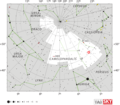| Emission nebula | |
|---|---|
| Planetary nebula | |
 False color image of NGC 1501. The central star is visible in the middle. | |
| Observation data: J2000 epoch | |
| Right ascension | 04h 06m 59.392s [1] |
| Declination | +60° 55′ 14.28″ [1] |
| Distance | 3,840 ± 770 ly (1.177 ± 0.236 kpc) [2] ly |
| Apparent magnitude (V) | 13.3 [3] |
| Apparent diameter | 52″ [3] |
| Constellation | Camelopardalis |
| Physical characteristics | |
| Radius | 0.5 ly |
| Designations | PK 144+6.1, PN G144.5+06.5, CS 14.4, CH Cam [4] |
NGC 1501 is a planetary nebula with a complex structure, located in the northern constellation of Camelopardalis. It has the proper names Camel's Eye Nebula and the Oyster Nebula. [3] The nebula was discovered on 27 August 1787 by the British-German astronomer William Herschel. [5] [6] The central star of NGC 1501 is located at a distance of approximately 3,840 light-years (1.177 kpc ) from the Sun, and is 29,280 light-years (8.978 kpc) from the Galactic Center. [2]


